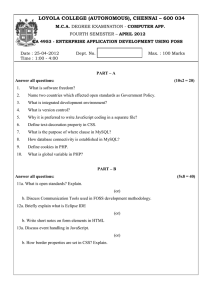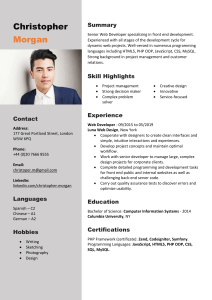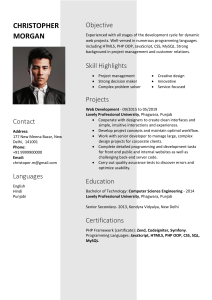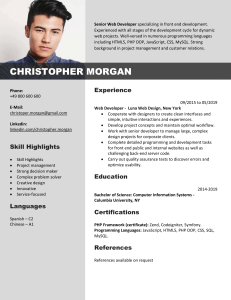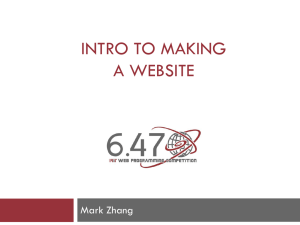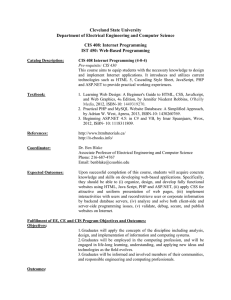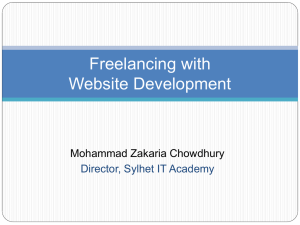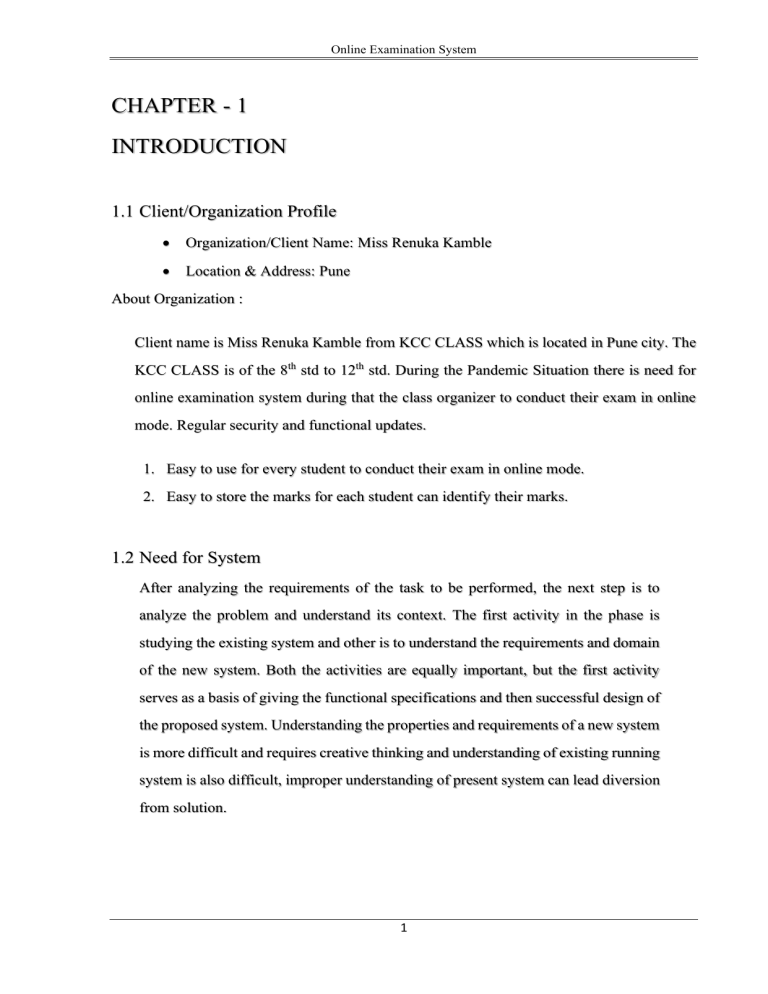
Online Examination System CHAPTER - 1 INTRODUCTION 1.1 Client/Organization Profile • Organization/Client Name: Miss Renuka Kamble • Location & Address: Pune About Organization : Client name is Miss Renuka Kamble from KCC CLASS which is located in Pune city. The KCC CLASS is of the 8th std to 12th std. During the Pandemic Situation there is need for online examination system during that the class organizer to conduct their exam in online mode. Regular security and functional updates. 1. Easy to use for every student to conduct their exam in online mode. 2. Easy to store the marks for each student can identify their marks. 1.2 Need for System After analyzing the requirements of the task to be performed, the next step is to analyze the problem and understand its context. The first activity in the phase is studying the existing system and other is to understand the requirements and domain of the new system. Both the activities are equally important, but the first activity serves as a basis of giving the functional specifications and then successful design of the proposed system. Understanding the properties and requirements of a new system is more difficult and requires creative thinking and understanding of existing running system is also difficult, improper understanding of present system can lead diversion from solution. 1 Online Examination System 1.3 Scope & Feasibility of Work Scope:1. The Application is based on problem to solve the student requirement. 2. It is Very helpful in Educational Application. 3. In this Application Examiner can take the test in mode of MCQ Test Exam. 4. Student can take the test in Anywhere to any location. 5. This Application is Only for KCC class. 6. Firstly student can register yourself and the to take the test. 7. Maintaining the database as required. Database can be modified accordingly. Feasibility of Work:Feasibility is the determination of whether or not a project is worth doing the process followed making this determination is called feasibility study. This of determines if a project can and should be taken. Once it has been determined that a project is feasible, the analyst can go ahead and prepare the project specification which finalizes project requirements. Generally, feasibility studies are undertaken within right time constraints and normally culminate in a written and oral feasibility report. 1. Technical feasibility: The technical issue usually raised during the feasibility stage of the investigation includes the following: • Does the necessary technology exist to do what is suggested? • Do the proposed equipments have the technical capacity to hold the data required to use the new system? • Will the proposed system provide adequate response to inquiries, regardless of the number or location of users? • Can the system be upgraded if developed? • Are there technical guarantees of accuracy, reliability, ease of access and data security? 2 Online Examination System 2. Operational Feasibility: Proposed projects are beneficial only if they can be turned out into information systems, which will meet the organization’s operating requirements. Operational feasibility aspects of the project are to be taken as an important part of the project implementation. Some of the important issues raised are to test the operational feasibility of a project includes the following: • Is there sufficient support for the management from the users? • Will the system be used and work properly if it is being developed and implemented? • Will there be any resistance from the user that will undermine the possible application benefits? This system is targeted to be in accordance with the above mentioned issues. Beforehand, the management issues and user requirements have been taken into consideration. So there is no question of resistance from the users that can undermine the possible application benefits. The well planned design would ensure the optimal utilization of the computer resources and would help in the improvement of performance status. 3. Economic feasibility: A system can be developed technically and that will be used if installed must still be a good investment for the organization. In the economical feasibility, the development cost in creating the system is evaluated against the ultimate benefit derived from the new systems. Financial benefits must equal or exceed the costs. The system is economically feasible. It does not require any additional hardware or software. 3 Online Examination System 1.4 Operating Environment- H/w & S/w 1.4.1 Hardware Specification • Hardware at client side: • Processor : Core i3. • Main Memory(RAM) : 1 GB or above. • Cache Memory : 1GB or above • Hard Disk : 150 GB or above. • Monitor : 14 inch Color Monitor • Mouse : Optical Mouse 1.4.2 Software Specification • Software at client side: • • Operating System : Windows 7 or above. Software at Development side: • Operating System : Windows 7 or above. • Database : MySQL • Frontend : PHP, Html, CSS, Bootstrap, JavaScript • Backend : MySQL. 1.5 Architecture of System The entire project mainly consists of 3 modules, which are ➢ Admin module ➢ Instructor module ➢ Student module Admin Module : Admin Module can doing the following tasks:- 4 Online Examination System 1. Register 2. Login 3. Change password and Forget password 4. Student Modifing Details 5. Department entering/Modify details 6. Give the test for the student which is managed by the Admin only. Instructor Module : Instructor Module can doing the following tasks:1. Register 2. Login 3. Change password and Forget password 4. Add Question-Department verify 5. Update Question-Department verify 6. Create Exam 7. Update Exam 8. View Exam details- view no of registered student view no of attended student 9. Evaluate Question- Multiple Choice Question Studemt Module : Student Module can doing the following tasks:- 1. Register 2. Login 3. Take Exam- Multiple Choice Question 4. See Exam Result 5. Logout 5 Online Examination System 1.6 Detail Description of Technology Used Following is a brief description of various technologies used while designing this system. 1. PHP 2. HTML 3. CSS 4. JavaScript 5. MySQL 1. PHP PHP started out as a small open source project that evolved as more and more people found out how useful it was. Rasmus Lerdorf unleashed the first version of PHP way back in 1994. • PHP is a recursive acronym for "PHP: Hypertext Preprocessor". • PHP is a server side scripting language that is embedded in HTML. It is used to manage dynamic content, databases, session tracking, even build entire e-commerce sites. • It is integrated with a number of popular databases, including MySQL, PostgreSQL, Oracle, Sybase, Informix, and Microsoft SQL Server. • PHP is pleasingly zippy in its execution, especially when compiled as an Apache module on the Unix side. The MySQL server, once started, executes even very complex queries with huge result sets in record-setting time. Common uses of PHP • PHP performs system functions, i.e. from files on a system it can create, open, read, write, and close them. • PHP can handle forms, i.e. gather data from files, save data to a file, through email you can send data, return data to the user. • You add, delete, modify elements within your database through PHP. • Access cookies variables and set cookies. • Using PHP, you can restrict users to access some pages of your website. • It can encrypt data. Characteristics of PHP Five important characteristics make PHP's practical nature possible − • Simplicity 6 Online Examination System • Efficiency • Security • Flexibility • Familiarity 2. HTML:HTML is an acronym which stands for Hyper Text Markup Language which is used for creating web pages and web applications. Let's see what is meant by Hypertext Markup Language, and Web page. Hyper Text: HyperText simply means "Text within Text." A text has a link within it, is a hypertext. Whenever you click on a link which brings you to a new webpage, you have clicked on a hypertext. HyperText is a way to link two or more web pages (HTML documents) with each other. Markup language: A markup language is a computer language that is used to apply layout and formatting conventions to a text document. Markup language makes text more interactive and dynamic. It can turn text into images, tables, links, etc. 3. Web Page: A web page is a document which is commonly written in HTML and translated by a web browser. A web page can be identified by entering an URL. A Web page can be of the static or dynamic type. With the help of HTML only, we can create static web pages. 4. CSS:Cascading Style Sheets, fondly referred to as CSS, is a simple design language intended to simplify the process of making web pages presentable. CSS handles the look and feel part of a web page. Using CSS, you can control the color of the text, the style of fonts, the spacing between paragraphs, how columns are sized and laid out, what background images or colors are used, layout designs,variations in display for different devices and screen sizes as well as a variety of other effects. 7 Online Examination System CSS is easy to learn and understand but it provides powerful control over the presentation of an HTML document. Most commonly, CSS is combined with the markup languages HTML or XHTML. Advantages of CSS • CSS saves time − You can write CSS once and then reuse same sheet in multiple HTML pages. You can define a style for each HTML element and apply it to as many Web pages as you want. • Pages load faster − If you are using CSS, you do not need to write HTML tag attributes every time. Just write one CSS rule of a tag and apply it to all the occurrences of that tag. So less code means faster download times. • Easy maintenance − To make a global change, simply change the style, and all elements in all the web pages will be updated automatically. • Superior styles to HTML − CSS has a much wider array of attributes than HTML. 5. Javascript:- JavaScript is a dynamic computer programming language. It is lightweight and most commonly used as a part of web pages, whose implementations allow client-side script to interact with the user and make dynamic pages. It is an interpreted programming language with object-oriented capabilities. JavaScript was first known as LiveScript, but Netscape changed its name to JavaScript, possibly because of the excitement being generated by Java. JavaScript made its first appearance in Netscape 2.0 in 1995 with the name LiveScript. The general-purpose core of the language has been embedded in Netscape, Internet Explorer, and other web browsers. 8 Online Examination System 6. MYSQL:- MySQL is an open-source relational database management system (RDBMS). Its name is a combination of “My”, the name of c0-funder Michael Widenius’s daughter, and “SQL”, the abbreviation for Structured Query Language. A relational database organizes data into one or more data tables in which data types may be related to each other, these relations help structure the data. SQL is a language programmers use to create, modify and extract data from the relational database, as well as control user access to the database. In addition to relational database and SQL, an RDBMS like MYSQL works an operating system to implement a relational database in a computer’s strong system, manages users, allows for network access and facilities testing database integrity and creation of backups. MySQL is free and open-source software under the term of the GNU General Public License and is also available under a variety of proprietary Licenses. MySQL was owned and sponsored by the Swedish company MySQL lab, which was bought by Sun Microsystems. In 2010, when Oracle acquired Sun, Widenius forked the open-source MySQL project to create MariaDB. MySQL has to stand alone clients that allow the user to interact directly with a MySQL database using SQL, but more often MySQL is used with another program to implement applications that need relational database capability. 9
